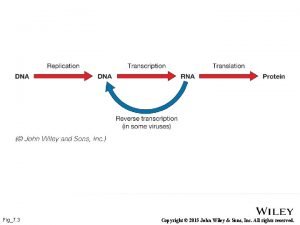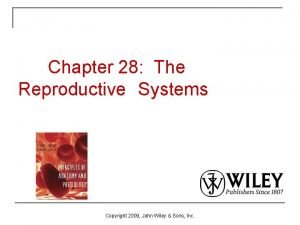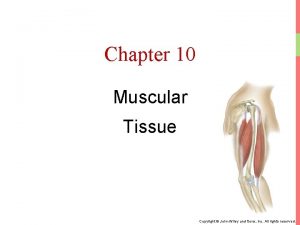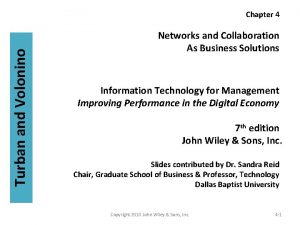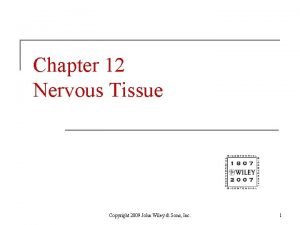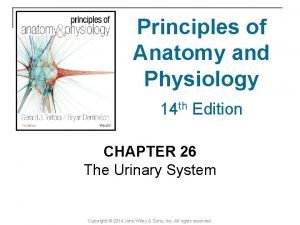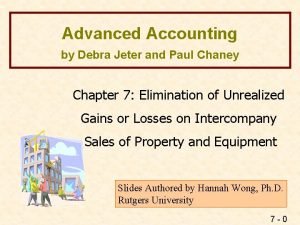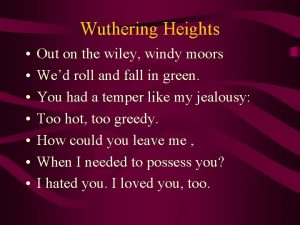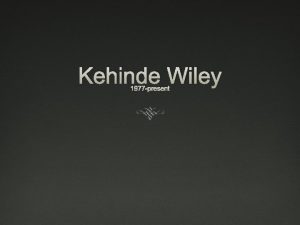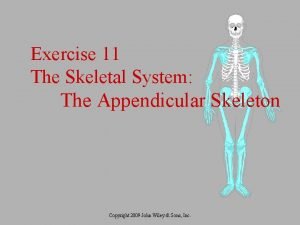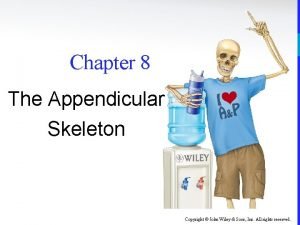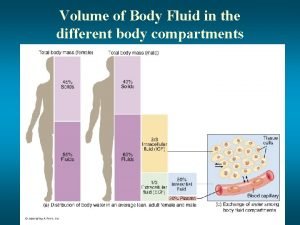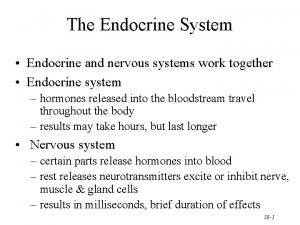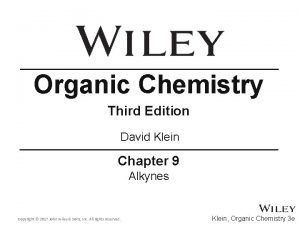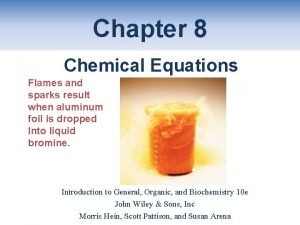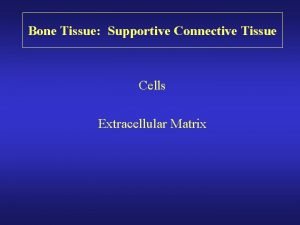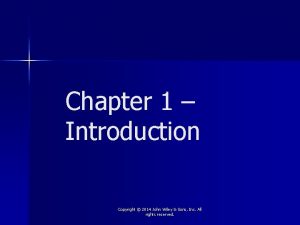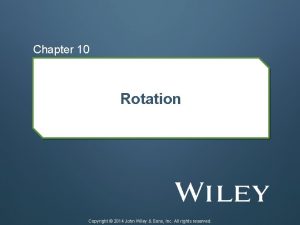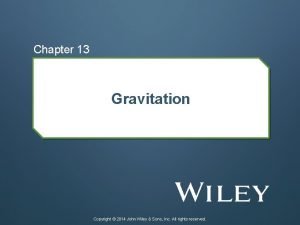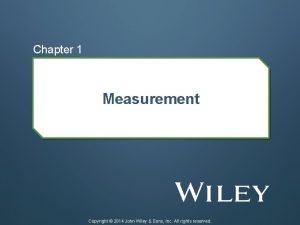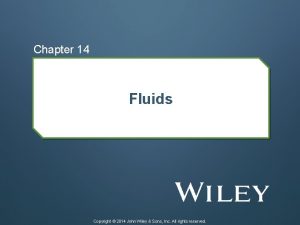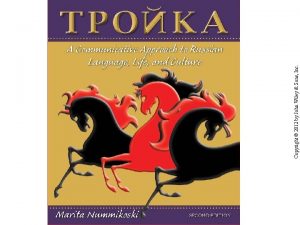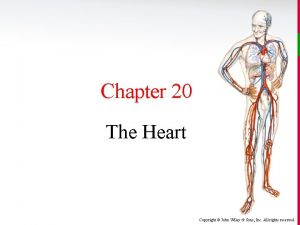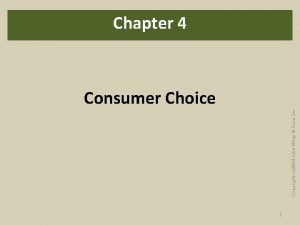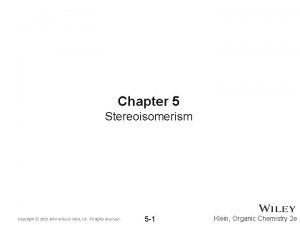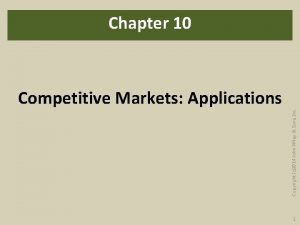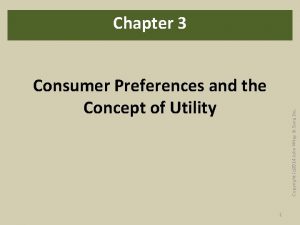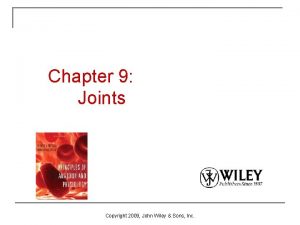Chapter 3 Vectors Copyright 2014 John Wiley Sons





























- Slides: 29

Chapter 3 Vectors Copyright © 2014 John Wiley & Sons, Inc. All rights reserved.

3 -1 Vectors and Their Components Learning Objectives 3. 01 Add vectors by drawing them in head-to-tail arrangements, applying the commutative and associative laws. 3. 02 Subtract a vector from a second one. 3. 04 Given the components of a vector, draw the vector and determine its magnitude and orientation. 3. 05 Convert angle measures between degrees and radians. 3. 03 Calculate the components of a vector on a given coordinate system, showing them in a drawing. © 2014 John Wiley & Sons, Inc. All rights reserved.

3 -1 Vectors and Their Components Physics deals with quantities that have both size and direction A vector is a mathematical object with size and direction A vector quantity is a quantity that can be represented by a vector Examples: position, velocity, acceleration Vectors have their own rules for manipulation A scalar is a quantity that does not have a direction Examples: time, temperature, energy, mass Scalars are manipulated with ordinary algebra © 2014 John Wiley & Sons, Inc. All rights reserved.

3 -1 Vectors and Their Components The simplest example is a displacement vector If a particle changes position from A to B, we represent this by a vector arrow pointing from A to B In (a) we see that all three arrows have the same magnitude and direction: they are identical displacement vectors. In (b) we see that all three paths correspond to the same displacement vector. The vector tells us nothing about the actual path that was taken between A and B. Figure 3 -1 © 2014 John Wiley & Sons, Inc. All rights reserved.

3 -1 Vectors and Their Components The vector sum, or resultant o o Is the result of performing vector addition Represents the net displacement of two or more displacement vectors Eq. (3 -1) o Can be added graphically as shown: Figure 3 -2 © 2014 John Wiley & Sons, Inc. All rights reserved.

3 -1 Vectors and Their Components Vector addition is commutative o We can add vectors in any order Eq. (3 -2) Figure (3 -3) © 2014 John Wiley & Sons, Inc. All rights reserved.

3 -1 Vectors and Their Components Vector addition is associative o We can group vector addition however we like Eq. (3 -3) Figure (3 -4) © 2014 John Wiley & Sons, Inc. All rights reserved.

3 -1 Vectors and Their Components A negative sign reverses vector direction Figure (3 -5) We use this to define vector subtraction Eq. (3 -4) Figure (3 -6) © 2014 John Wiley & Sons, Inc. All rights reserved.

3 -1 Vectors and Their Components These rules hold for all vectors, whether they represent displacement, velocity, etc. Only vectors of the same kind can be added o (distance) + (distance) makes sense o (distance) + (velocity) does not Answer: (a) 3 m + 4 m = 7 m (b) 4 m - 3 m = 1 m © 2014 John Wiley & Sons, Inc. All rights reserved.

3 -1 Vectors and Their Components Rather than using a graphical method, vectors can be added by components o A component is the projection of a vector on an axis The process of finding components is called resolving the vector The components of a vector can be positive or negative. They are unchanged if the vector is shifted in any direction (but not rotated). © 2014 John Wiley & Sons, Inc. All rights reserved. Figure (3 -8)

3 -1 Vectors and Their Components in two dimensions can be found by: Eq. (3 -5) Where θ is the angle the vector makes with the positive x axis, and a is the vector length The length and angle can also be found if the components are known Eq. (3 -6) Therefore, components fully define a vector © 2014 John Wiley & Sons, Inc. All rights reserved.

3 -1 Vectors and Their Components In the three dimensional case we need more components to specify a vector o (a, θ, φ) or (ax, ay, az) Answer: choices (c), (d), and (f) show the components properly arranged to form the vector © 2014 John Wiley & Sons, Inc. All rights reserved.

3 -1 Vectors and Their Components Angles may be measured in degrees or radians Recall that a full circle is 360˚, or 2π rad Know the three basic trigonometric functions Figure (3 -11) © 2014 John Wiley & Sons, Inc. All rights reserved.

3 -2 Unit Vectors, Adding Vectors by Components Learning Objectives 3. 06 Convert a vector between magnitude-angle and unitvector notations. 3. 07 Add and subtract vectors in magnitude-angle notation and in unit-vector notation. 3. 08 Identify that, for a given vector, rotating the coordinate system about the origin can change the vector's components, but not the vector itself. © 2014 John Wiley & Sons, Inc. All rights reserved.

3 -2 Unit Vectors, Adding Vectors by Components A unit vector o Has magnitude 1 o Has a particular direction Eq. (3 -7) o Lacks both dimension and unit Eq. (3 -8) o Is labeled with a hat: ^ We use a right-handed coordinate system o Remains right-handed when rotated Figure (3 -13) © 2014 John Wiley & Sons, Inc. All rights reserved.

3 -2 Unit Vectors, Adding Vectors by Components The quantities axi and ayj are vector components Eq. (3 -7) Eq. (3 -8) The quantities ax and ay alone are scalar components o Or just “components” as before Vectors can be added using components Eq. (3 -9) → Eq. (3 -10) Eq. (3 -11) Eq. (3 -12) © 2014 John Wiley & Sons, Inc. All rights reserved.

3 -2 Unit Vectors, Adding Vectors by Components To subtract two vectors, we subtract components Eq. (3 -13) Unit Vectors, Adding Vectors by Components Answer: (a) positive, positive (b) positive, negative (c) positive, positive © 2014 John Wiley & Sons, Inc. All rights reserved.

3 -2 Unit Vectors, Adding Vectors by Components Vectors are independent of the coordinate system used to measure them We can rotate the coordinate system, without rotating the vector, and the vector remains the same Eq. (3 -14) Eq. (3 -15) All such coordinate systems are equally valid Figure (3 -15) © 2014 John Wiley & Sons, Inc. All rights reserved.

3 -3 Multiplying Vectors Learning Objectives 3. 09 Multiply vectors by scalars. 3. 13 Given two vectors, use the dot product to find out 3. 10 Identify that multiplying a how much of one vector lies vector by a scalar gives a along the other. vector, the dot product gives a scalar, and the cross 3. 14 Find the cross product of product gives a two vectors. perpendicular vector. 3. 15 Use the right-hand rule to 3. 11 Find the dot product of find the direction of the two vectors. resultant vector. 3. 12 Find the angle between two vectors by taking their dot product. 3. 16 In nested products, start with the innermost product and work outward. © 2014 John Wiley & Sons, Inc. All rights reserved.

3 -3 Multiplying Vectors Multiplying a vector z by a scalar c o Results in a new vector o Its magnitude is the magnitude of vector z times |c| o o Its direction is the same as vector z, or opposite if c is negative To achieve this, we can simply multiply each of the components of vector z by c To divide a vector by a scalar we multiply by 1/c Example Multiply vector z by 5 o z = -3 i + 5 j o 5 z = -15 i + 25 j © 2014 John Wiley & Sons, Inc. All rights reserved.

3 -3 Multiplying Vectors Multiplying two vectors: the scalar product o o Also called the dot product Results in a scalar, where a and b are magnitudes and φ is the angle between the directions of the two vectors: Eq. (3 -20) The commutative law applies, and we can do the dot product in component form Eq. (3 -22) Eq. (3 -23) © 2014 John Wiley & Sons, Inc. All rights reserved.

3 -3 Multiplying Vectors A dot product is: the product of the magnitude of one vector times the scalar component of the other vector in the direction of the first vector Eq. (3 -21) Figure (3 -18) Either projection of one vector onto the other can be used To multiply a vector by the projection, multiply the magnitudes © 2014 John Wiley & Sons, Inc. All rights reserved.

3 -3 Multiplying Vectors Answer: (a) 90 degrees (b) 0 degrees (c) 180 degrees © 2014 John Wiley & Sons, Inc. All rights reserved.

3 -3 Multiplying Vectors Multiplying two vectors: the vector product o The cross product of two vectors with magnitudes a & b, separated by angle φ, produces a vector with magnitude: Eq. (3 -24) o And a direction perpendicular to both original vectors Direction is determined by the right-hand rule Place vectors tail-to-tail, sweep fingers from the first to the second, and thumb points in the direction of the resultant vector © 2014 John Wiley & Sons, Inc. All rights reserved.

3 -3 Multiplying Vectors Figure (3 -19) The upper shows vector a cross vector b, the lower shows vector b cross vector a © 2014 John Wiley & Sons, Inc. All rights reserved.

3 -3 Multiplying Vectors The cross product is not commutative Eq. (3 -25) To evaluate, we distribute over components: Eq. (3 -26) Therefore, by expanding (3 -26): Eq. (3 -27) © 2014 John Wiley & Sons, Inc. All rights reserved.

3 -3 Multiplying Vectors Answer: (a) 0 degrees (b) 90 degrees © 2014 John Wiley & Sons, Inc. All rights reserved.

3 Summary Scalars and Vectors Adding Geometrically Scalars have magnitude only Vectors have magnitude and direction Eq. (3 -2) Eq. (3 -3) Both have units! Vector Components Unit Vector Notation Given by Eq. (3 -5) Obeys commutative and associative laws We can write vectors in terms of unit vectors Eq. (3 -7) Related back by Eq. (3 -6) © 2014 John Wiley & Sons, Inc. All rights reserved.

3 Summary Adding by Components Add component-by-component Scalar Times a Vector Eqs. (3 -10) - (3 -12) Scalar Product is a new vector Magnitude is multiplied by scalar Direction is same or opposite Cross Product Dot product Eq. (3 -20) Produces a new vector in perpendicular direction Direction determined by righthand rule Eq. (3 -22) © 2014 John Wiley & Sons, Inc. All rights reserved. Eq. (3 -24)
 John wiley & sons
John wiley & sons John wiley & sons
John wiley & sons Chapter 10 muscle tissue
Chapter 10 muscle tissue John wiley & sons, inc.
John wiley & sons, inc. John wiley & sons, inc.
John wiley & sons, inc. Action potential strength
Action potential strength Wiley and sons
Wiley and sons There was a man who had four son
There was a man who had four son There was a man who had four sons
There was a man who had four sons John wiley
John wiley Copyright 2014 pearson education inc
Copyright 2014 pearson education inc Onlinelibrary-wiley-com
Onlinelibrary-wiley-com Dorothy irene wiley
Dorothy irene wiley Advanced accounting wiley
Advanced accounting wiley Genie wiley
Genie wiley Out on the wiley windy moors
Out on the wiley windy moors Kehinde wiley bio
Kehinde wiley bio Management information systems wiley
Management information systems wiley Afrodizzia medicine
Afrodizzia medicine Sacroiliac bone
Sacroiliac bone Onlytoc
Onlytoc Wiley
Wiley Ward v wilbanks
Ward v wilbanks Wiley
Wiley Wiley
Wiley Wiley
Wiley Alkyne to alcohol
Alkyne to alcohol Flykda
Flykda Phosphorus chemical equation
Phosphorus chemical equation Wiley
Wiley
